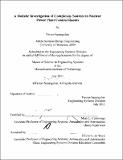| dc.contributor.advisor | Mary L. Cummings. | en_US |
| dc.contributor.author | Sasangohar, Farzan | en_US |
| dc.contributor.other | Massachusetts Institute of Technology. Engineering Systems Division. | en_US |
| dc.date.accessioned | 2012-01-12T19:34:00Z | |
| dc.date.available | 2012-01-12T19:34:00Z | |
| dc.date.issued | 2011 | en_US |
| dc.identifier.uri | http://hdl.handle.net/1721.1/68516 | |
| dc.description | Thesis (S.M.)--Massachusetts Institute of Technology, Engineering Systems Division, System Design and Management Program, September 2011. | en_US |
| dc.description | "July 2011." Cataloged from PDF version of thesis. | en_US |
| dc.description | Includes bibliographical references (p. 99-104). | en_US |
| dc.description.abstract | The nuclear power community in the United States is moving to modernize aging power plant control rooms as well as develop control rooms for new reactors. New generation control rooms, along with modernized control rooms, will rely more heavily on automation and computerized procedures. Of particular importance to the Nuclear Regulatory Commission (NRC) is the impact such modernizations or new technologies will have upon operator performance and reliability in these safety-critical control room environments. One specific area of interest is the effect that various complexities in the control room have on operator performance and reliability. This research identifies various definitions of complexity and characterizes complexity in the nuclear power plant (NPP) domain, focusing on the common complexity dimensions of number, variety, and interconnections. Based on this characterization of complexity, a comprehensive list of complexity sources within the NPP control room is presented, along with a novel approach to describe complexity source interconnections. Understanding the sources of complexity in advanced NPP control rooms and the associated effects on human reliability is critical for ensuring safe performance of both operators and the entire system. However, most of the previous approaches in investigating complexity typically focus on either objective or subjective views of complexity, and a systematic approach that considers both views is missing from previous approaches. This research provides a novel methodology to assess the sources of complexity in NPP control rooms both objectively and subjectively while understanding the difference between the two and introduces a systems theoretic descriptive model of these sources of complexity, leveraging network theory. Finally a method is introduced to investigate the differences between the complexity views of different groups of NPP stakeholders. Incident report databases and in particular, 22 nuclear incidents in the Human Event Repository and Analysis (HERA) database were parsed to find objective evidence for the identified sources. Using this evidence-based approach, some of the potential interactions between these sources could be captured. A network called "Complexity Source Network" (CSN) was created for each incident in HERA to present the sources (nodes) and potential interactions between them (links). An ensemble of networks was developed consisting of 22 CSNs, one for each of the incidents in HERA. A tool called CXViz was developed to visualize and analyze the CSNs. Using the aggregate network (22 CSNs combined) the most common sources and interactions were identified. The complexity views of three groups of stakeholders, namely Operators, Designers and NRC Reviewers, were collected using a survey tool called CXSurvey. Using this tool, the interviewees were asked to rate the identified sources of perceived complexity and to rank the top five in terms of contribution to perceived complexity. Data gathered from 16 operators, 8 designers and 3 NRC reviewers were collected and the top five sources identified by each group were compared to the top five most supported sources from the 22 incidents in HERA. The results show large variations between the subjective views of the operators and designers and the objective top five. In addition, the subjective source rating of the three groups of stakeholders were compared. The results show large variations between the complexity views between the stakeholders on some controversial sources such as boredom, and training. | en_US |
| dc.description.statementofresponsibility | by Farzan Sasangohar. | en_US |
| dc.format.extent | 212 p. | en_US |
| dc.language.iso | eng | en_US |
| dc.publisher | Massachusetts Institute of Technology | en_US |
| dc.rights | M.I.T. theses are protected by
copyright. They may be viewed from this source for any purpose, but
reproduction or distribution in any format is prohibited without written
permission. See provided URL for inquiries about permission. | en_US |
| dc.rights.uri | http://dspace.mit.edu/handle/1721.1/7582 | en_US |
| dc.subject | Engineering Systems Division. | en_US |
| dc.title | A holistic investigation of complexity sources in nuclear power plant control rooms | en_US |
| dc.type | Thesis | en_US |
| dc.description.degree | S.M. | en_US |
| dc.contributor.department | System Design and Management Program. | en_US |
| dc.contributor.department | Massachusetts Institute of Technology. Engineering Systems Division | |
| dc.identifier.oclc | 770706702 | en_US |
